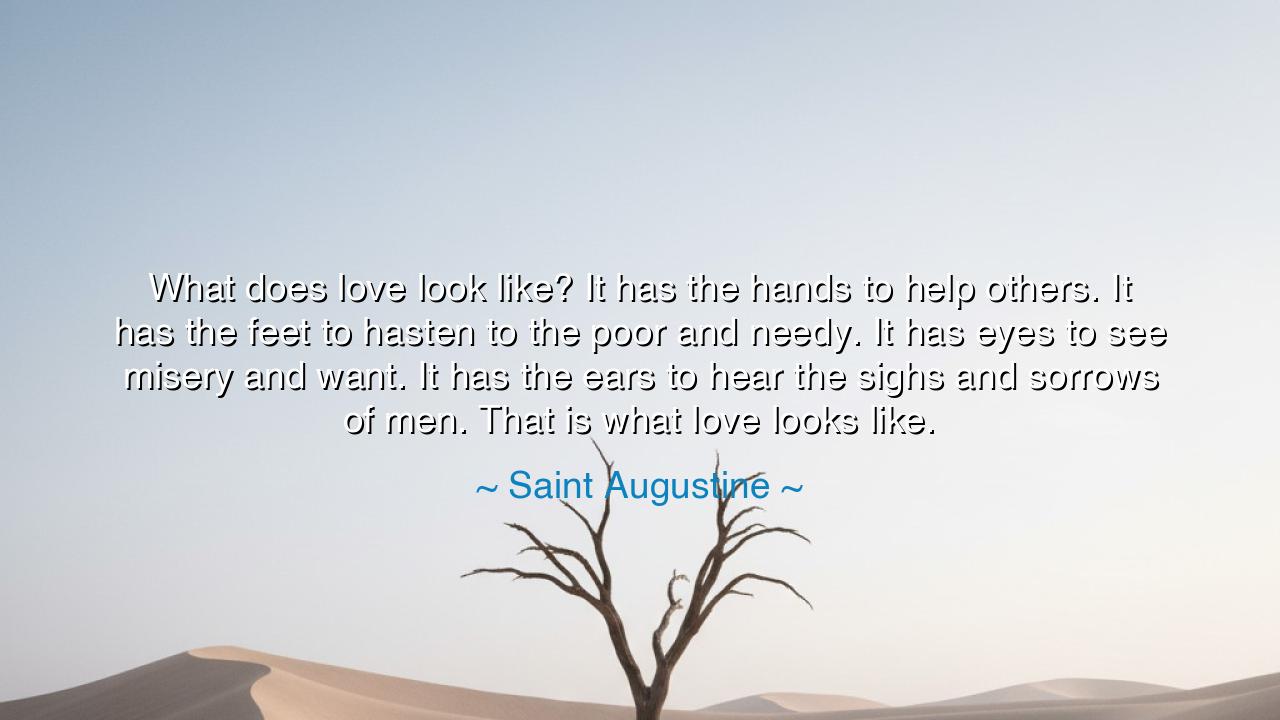
What does love look like? It has the hands to help others. It has
What does love look like? It has the hands to help others. It has the feet to hasten to the poor and needy. It has eyes to see misery and want. It has the ears to hear the sighs and sorrows of men. That is what love looks like.






"What does love look like? It has the hands to help others. It has the feet to hasten to the poor and needy. It has eyes to see misery and want. It has the ears to hear the sighs and sorrows of men. That is what love looks like." Thus spoke Saint Augustine, the great father of the Church, the restless seeker of truth who found his peace in God. In this vision of words, Augustine does not speak of love as a feeling or an idea, but as a living power—an incarnate spirit that moves through flesh and action. To him, love is not to be admired from afar; it must walk, see, hear, touch, and serve. For love that does not act is not love at all—it is but the shadow of affection, empty as a word spoken without meaning.
The origin of these words lies deep within Augustine’s theology of caritas—divine charity—the highest form of love that mirrors the nature of God Himself. Before he was a saint, Augustine lived a life of indulgence and pride, chasing pleasures and knowledge in equal measure. But when grace touched his soul, he realized that love was not found in the self’s desires, but in the self’s surrender. Through his conversion, he came to see that true love is service, not sentiment. His quote springs from this understanding: that to love God truly is to love His creation—to see His face in every hungry child, every sorrowful stranger, every broken heart.
"It has the hands to help others." In this first image, Augustine reveals the sacred truth that love is action. Hands that pray are holy, but hands that lift the fallen, feed the hungry, and comfort the weak are holiness made visible. Love is not a hidden flame in the heart; it is a fire that warms others. The one who loves cannot remain still while others suffer, for compassion demands movement. The hands of love are instruments of mercy, building the kingdom of heaven upon the soil of earth.
"It has the feet to hasten to the poor and needy." Augustine’s love does not wait for the world to come asking—it goes forth, swift and eager. Love is restless until it serves. Like the Christ who walked dusty roads to reach the sick and forgotten, true love hastens toward pain, not away from it. It does not linger in comfort but runs to where it is needed most. The feet of love are the messengers of hope, bringing light into the dark corners of the human condition.
Consider the life of Mother Teresa, who carried Augustine’s vision into the modern age. She saw the face of Christ in the dying and the destitute, and she hastened to them without hesitation. Her hands bathed the wounds of lepers; her feet walked the alleys of Calcutta; her eyes saw suffering where others saw waste; her ears heard prayers whispered in despair. Her entire being became a living answer to Augustine’s question, “What does love look like?” For in her, love took form—not as poetry or philosophy, but as compassion in motion.
"It has eyes to see misery and want. It has the ears to hear the sighs and sorrows of men." These are the senses of the soul awakened by divine love. Many see, but do not perceive; many hear, but do not listen. True love opens the eyes of the heart to see beyond appearances, to recognize the invisible wounds carried by others. It hears not only the words spoken, but the silence behind them—the sigh of loneliness, the cry of injustice. To love is to become aware, to live not only for oneself but for the whole of humanity. Augustine teaches that love is perception transformed into compassion, compassion transformed into action.
And when he concludes, “That is what love looks like,” he speaks with the authority of one who has walked the road from pride to humility, from blindness to vision. Love, for Augustine, is the reflection of God’s own nature—the power that created the world and redeems it still. It is not passive adoration but living imitation. To love is to become the hands, feet, eyes, and ears of the divine upon the earth—to allow God’s mercy to flow through one’s own being. In this way, love becomes not an emotion to feel, but a mission to fulfill.
So, my listener, take this teaching to heart: let your love be visible. Do not hide it behind words or intentions. Let your hands serve, your feet move, your eyes notice, and your ears listen. Seek out the weary, the forgotten, the voiceless. Love not with your lips, but with your life. For in the end, it is not what we claim to feel that will matter, but what we have done out of love.
And thus, the lesson of Saint Augustine endures: Love is not a dream, but a duty; not a mystery far away, but a calling close at hand. It is the light that shines when we act with mercy, the divine echo that resounds when we serve the least among us. To love is to live as God intended—to turn compassion into flesh, and to make heaven visible on earth. That is what love looks like.






AAdministratorAdministrator
Welcome, honored guests. Please leave a comment, we will respond soon